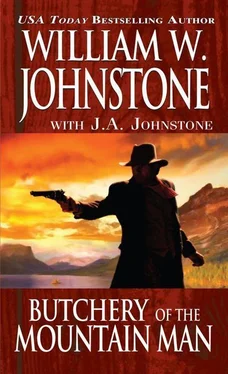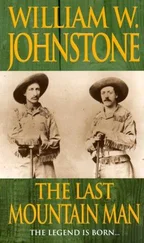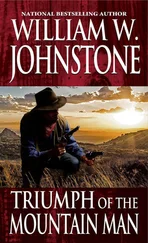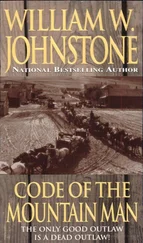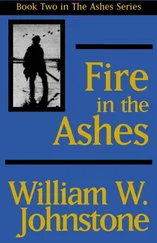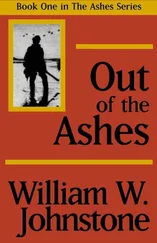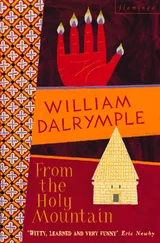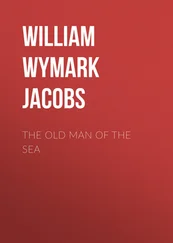There have been many books written about Smoke Jensen, and as he is generally considered to be a true treasure of Colorado, there will be many more. And, no doubt, many of these books, especially those that make no pretense of being anything more than a novel, will attempt to build upon a basis of truth, a degree of fact and fiction ingeniously combined.
I am attempting in this endeavor to present the stories of Smoke Jensen and John Jackson’s life as truthfully as I can. But the plain fact, perhaps not understood by those of us in the twentieth century, is that men like Jensen and Jackson lived the kind of lives that are written about by such men as Owen Wister and Zane Grey, or portrayed by Tom Mix and William S. Hart. Such men are passing from the scene, but they will never pass from our history.—ED. ]
Montana—late September 1869
The trapping didn’t really start until the cold came because, as Smoke explained, it wasn’t until then that the beaver and marten would have their full coats.
“All right, this looks like a good place,” Smoke said.
“The old man, Preacher, has he been out here long?” John asked, as the two men started unloading their traps.
“He came out here soon after the War of 1812,” Smoke said. “And he was taken in by a couple of old-timers who had been here since the late seventeen hundreds.”
“Late seventeen hundreds? That was before Lewis and Clark.”
“Which Preacher’s friends described as nice young men, who were wet behind the ears.”
“Ha! It would have been interesting to meet them. But then, Preacher is an interesting man too.”
“More than interesting. He is one of the finest, if not the finest man I have ever met. Let’s get some traps out. La langue n’attrape pas le castor .”
“What did you just say? I know that it is French, but I must confess that I learned very little while I was in the Foreign Legion.”
Smoke laughed. “It’s a saying that Preacher learned from his friend, Pierre Garneau. It means ‘the tongue does not catch the beaver.’”
John laughed as well. “ La langue n’attrape pas le castor. Very good, I shall have to remember that.”
After trapping for several weeks, and skinning and cleaning the beaver pelts, several buffalo came by.
“John, have you ever eaten buffalo?” Smoke asked.
“I can’t say as I have.”
“Your Sharps fires a heavy enough bullet to take one down. I’ll give you the honor. Come with me.”
The two men approached the buffalo . . . not part of a large herd, there were no more than six in the group.
“Do you think you can hit one from here?”
“Yes.”
“That one,” Smoke said, pointing one of them out.
John slipped a .50 caliber bullet into the chamber, closed the block, and took aim, and fired.
A puff of dust flew up from the buffalo’s coat, its front legs buckled, then straightened as the animal fought to stay on its feet, then it went down. The sound of the gunshot rolled back in repeating echoes.
“Great shot, John!” Smoke said.
“They didn’t run,” John said, puzzled.
“That’s because you shot the leader. Since he didn’t run, none of the others did either. Now, shoot that one, and we’ll both have a robe for the winter.”
John shot the second buffalo, and this time the remaining four did run. Smoke and John hurried out to the downed buffalo and discovered that both were dead by the time they got there.
[ Less than twenty years after the experience described above, the buffalo were very nearly extinct. Dr. William T. Hornaday of the National Museum directed public attention to the impending extinction of the buffalo. In 1889, he conducted a census which disclosed only 1,091 living buffaloes in the entire world. Another census taken in 1903 turned up only 969, in forty-one herds in the United States, and an additional 675 in Canada, for a world total of 1,644.
It is easy to point to the cause. Some might say that they were hunted out during the westward expansion of the railroad, and to a degree that is true. But it is also true that the survival of the buffalo did not have a very high degree of importance among the western settlers, whose economy was incompatible with the continued existence of the buffalo. Today the cattle on a thousand hills provide a far greater economic resource than the buffalo, if left to thrive in their primitive paradise, could possibly supply.—ED. ]
“We’ve got some work to do,” Smoke said, pointing to the two dead animals.
After skinning the two buffalo, their hides had to be fleshed and thinned. Smoke started at the edges, and began removing the meat and the fat, using a very sharp knife, and working his way toward the center.
The buffalo had already been butchered into chunks of meat that weren’t too heavy to carry, and those chunks were hanging from the limbs of a tree to keep the wolves away.
“We’ll have meat all winter,” Smoke said. “The cold will keep the meat fresh.”
“I have got to get me a better knife than this,” John said as he tried to emulate Smoke’s work on the hides. “This damn thing is as worthless as tits on a boar hog.”
“You need a Bowie knife,” Smoke said, showing his.
“Well, since I’m not helping much with the cleaning of the skin, suppose I get a fire started and we carve off some of that buffalo for supper.”
“Sounds like a good idea to me,” Smoke said, without looking up.
Smoke continued to work on the buffalo skin while John began gathering wood for the fire.
“Smoke?” John said a moment later. There was quiet urgency in his voice.
“What?”
“We’ve got company coming.”
“Trouble?” Smoke asked.
John shook his head. “I don’t know. I don’t think so, though, because there are women with them.”
Smoke dipped his hands in the icy cold water to wash off the blood and tissue that had been collected from the inside of the buffalo skin. When his hands were clean, he stood up to watch the Indians approach. There were seven of them, three men and four women. One of the men and one of the women were very old.
Smoke held his hand up, palm out as the Indians approached.
“I am Ketano,” the oldest of the men said.
“I am Smoke.”
The Indian looked confused, and he made the symbol of smoke with his hand twirling around and lifting.
“Smoke?” he asked, not sure he understood the name.
“Yes, Smoke,” Smoke said, repeating the hand sign, then pointing to himself.
The old Indian smiled. “It is a good name,” he said, then he repeated to the others, saying the name both in English and his own language.
“What kind of Indians are these?” John asked.
“Mandan, I expect,” Smoke said. “More than likely if they were Crow, they would be after our scalps.”
“Trade?” Ketano asked, again backing up his English with sign language.
“Yes, we will trade,” Smoke said. “What do we have that you want?”
“Buffalo meat,” Ketano said, pointing to the hanging chunks.
Smoke walked over to the meat and put his hand on one of the two humps. “This you cannot have,” he said. He pointed to the rest of the meat. “You may take some of the remaining meat.”
Again Ketano spoke to the others. They laughed, and one of them said something.
“He says you know what part of buffalo is good,” Ketano said.
“What have you got to trade?” Smoke asked.
The Indians had honey, corn, dried berries, and wild greens. They also had a beaded knife sheath that John wanted.
Before they left, Ketano gave Smoke and John a warning.
“The Crow do not like the white men trapping here,” he said. “I think if they can, they will kill you.”
Читать дальше
